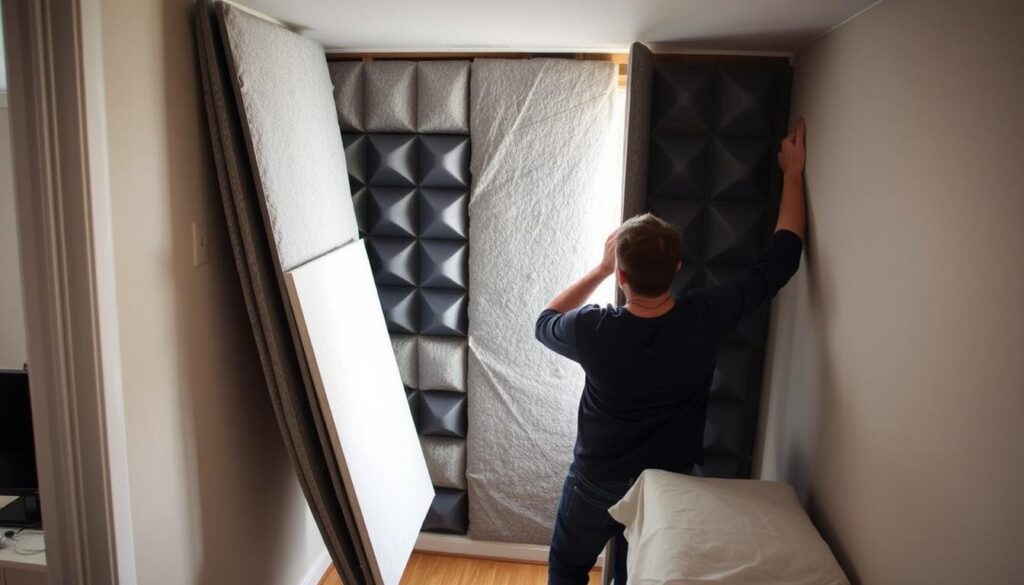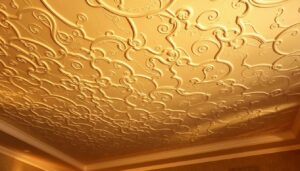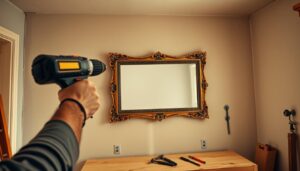Are you tired of being disturbed by noise from neighbouring properties? If so, you’re not alone. Many UK homeowners struggle with unwanted sound transmitted through shared party walls.
Effective soundproofing can significantly enhance your quality of life, reducing stress caused by noise disturbance. This comprehensive guide will walk you through various DIY techniques to tackle noise issues, from simple, budget-friendly solutions to more advanced methods.
Proper soundproofing can be achieved by understanding noise problems, assessing your needs, preparing accordingly, and implementing suitable installation techniques. Our guide follows UK building regulations and standards for soundproofing, ensuring you achieve the best possible results.
Key Takeaways
- Understand the causes of noise disturbance through party walls.
- Assess your soundproofing needs based on the type of noise and wall construction.
- Implement DIY soundproofing techniques suitable for your wall type.
- Enhance your soundproofing with additional materials and methods.
- Ensure compliance with UK building regulations and soundproofing standards.
Understanding Party Wall Noise Problems
Understanding the complexities of party wall noise is crucial for effective soundproofing. Noise issues with party walls can significantly impact the quality of life for residents in shared dwellings.
What Is a Party Wall?
A party wall is a shared wall that separates two dwellings, such as apartments or houses. It is a common feature in many residential buildings, particularly in urban areas.
Common Sources of Noise Through Party Walls
Noise can travel through party walls due to various sources, including airborne noise (voices, music) and impact noise (footsteps, door slamming). Understanding these sources is key to addressing the issue.
| Noise Type | Common Sources |
|---|---|
| Airborne Noise | Voices, Music, TV Sounds |
| Impact Noise | Footsteps, Door Slamming, Furniture Moving |
UK Building Regulations for Party Walls
The UK Building Regulations, specifically Part E, set minimum soundproofing standards for new residential buildings with shared walls. Newer properties (built after 2003) are expected to meet these standards, while older properties may not.
- New builds must comply with Part E standards for sound insulation.
- Converted properties have different standards, which may not be as stringent.
- Local building control departments can provide guidance on compliance.
Types of Noise to Address
Noise through party walls can be categorized into different types, each requiring a unique soundproofing approach. Understanding these categories is essential for effective noise reduction.
Airborne Noise Explained
Airborne noise refers to sound that travels through the air, such as voices, music, or television audio. This type of noise is a common problem in shared living spaces. Airborne noise can be mitigated by improving the sound insulation properties of the wall, often by adding mass or decoupling the wall surfaces to reduce sound transmission. The frequency of the noise also plays a role in determining the most effective soundproofing method.
Impact Noise Challenges
Impact noise, generated by physical impacts like footsteps or door slamming, is more challenging to address. It travels through the building’s structure, making it harder to isolate. Decoupling techniques and additional treatments to floors or ceilings may be necessary to effectively reduce impact noise transmission through party walls.
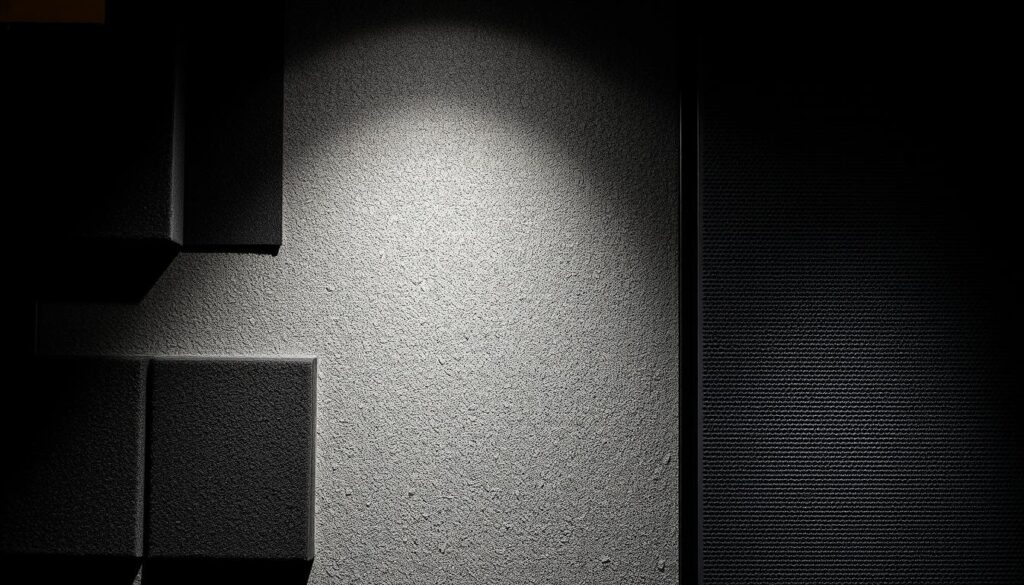
Assessing Your Soundproofing Needs
Before embarking on a DIY soundproofing project, it’s crucial to assess your specific needs. Understanding the extent of your noise problem and the potential effectiveness of DIY solutions will help you achieve the best possible results.
Determining the Severity of Your Noise Problem
To effectively soundproof your party wall, you first need to determine the severity of the noise issue you’re facing. Loud noise and low-frequency sounds are typically the most challenging to mitigate. Consider the type of noise you’re dealing with and its impact on your daily life.
Setting Realistic Expectations for DIY Solutions
DIY soundproofing can significantly reduce noise transmission but rarely eliminates it completely, especially for low-frequency sounds. The effectiveness of soundproofing depends on multiple factors, including wall construction, type of noise, and available space for solutions. Understanding these factors and the law of diminishing returns will help you set realistic expectations for your project’s outcomes.
| Soundproofing Method | Noise Reduction | Effectiveness |
|---|---|---|
| DIY Solutions | 40-60% | Moderate |
| Professional Solutions | 70-90% | High |
Managing your expectations is crucial for satisfaction with the results of any DIY soundproofing project. By understanding the potential outcomes and limitations, you can make informed decisions and achieve the best possible noise reduction for your party wall.
Preparation Before Soundproofing
Before diving into soundproofing your party wall, it’s essential to prepare adequately to achieve the best results. This preparation involves understanding the tools and materials required for the task and taking necessary safety precautions.
Tools and Materials You’ll Need
To soundproof your party wall effectively, you’ll need specific tools and materials. For a comprehensive soundproofing system, consider using acoustic mineral wool, plasterboard, and resilient bars. You can find these soundproofing tools in the UK at most hardware stores or online retailers.
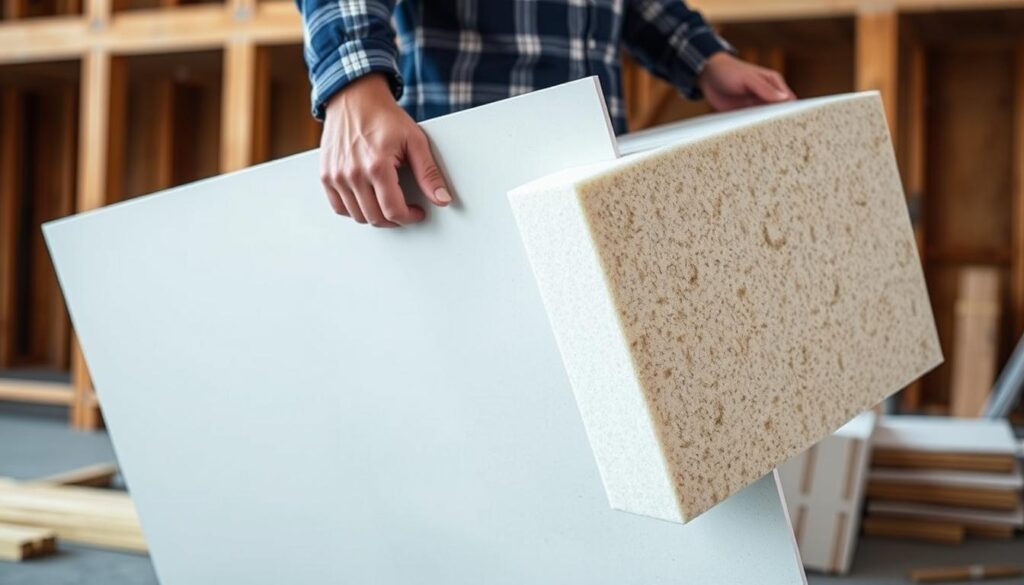
Safety Considerations for DIY Installation
When undertaking DIY soundproofing, safety should be your top priority. Here are some key considerations:
- Personal Protective Equipment (PPE): Wear dust masks, safety goggles, and gloves when handling insulation materials and cutting plasterboard.
- Electrical Safety: Identify and work around electrical outlets and wiring in party walls to avoid accidents.
- Safe Lifting Techniques: Use proper lifting methods when handling heavy materials like plasterboard and mineral wool to prevent back injuries.
- Proper Ventilation: Ensure good ventilation when using adhesives and sealants during the installation process.
- Hazards in Older Properties: Be aware of potential hazards like lead paint or asbestos in older properties that might be disturbed during preparation work.
- Tool Safety: Exercise caution when using power tools for cutting materials or fixing to walls.
- First Aid Kit: Have a first aid kit readily available and work with a partner when handling large or heavy materials.
- Cable Detection: Check for pipes and cables in walls before drilling or fixing, using a cable detector where appropriate.
Addressing Flanking Noise First
Before diving into party wall soundproofing, it’s essential to understand and mitigate flanking noise. Flanking noise refers to the sound that travels around or through the wall via other paths, such as ceilings, floors, or adjacent structures. If not addressed, it can significantly undermine your soundproofing efforts.
Soundproofing Adjacent Floors
When dealing with flanking noise, it’s crucial to soundproof adjacent floors. If there’s another habitable room above the ceiling, consider installing 100mm of acoustic mineral wool between the joists, adjacent to the separating wall. This can be achieved by lifting a few floorboards. For top-floor rooms, ensure that there’s adequate loft insulation, meeting current thermal insulation requirements.
Ceiling Soundproofing Techniques
Ceiling treatment is vital for comprehensive party wall soundproofing, as sound can travel over the walls through ceiling voids. For effective ceiling soundproofing, consider adding layers of acoustic plasterboard to the existing ceiling or using resilient ceiling bars to decouple the ceiling surface from the structure. For period properties with lath and plaster ceilings, handle with care to avoid damage. By combining floor and ceiling treatments with wall soundproofing, you create a comprehensive sound barrier that addresses all potential noise paths.
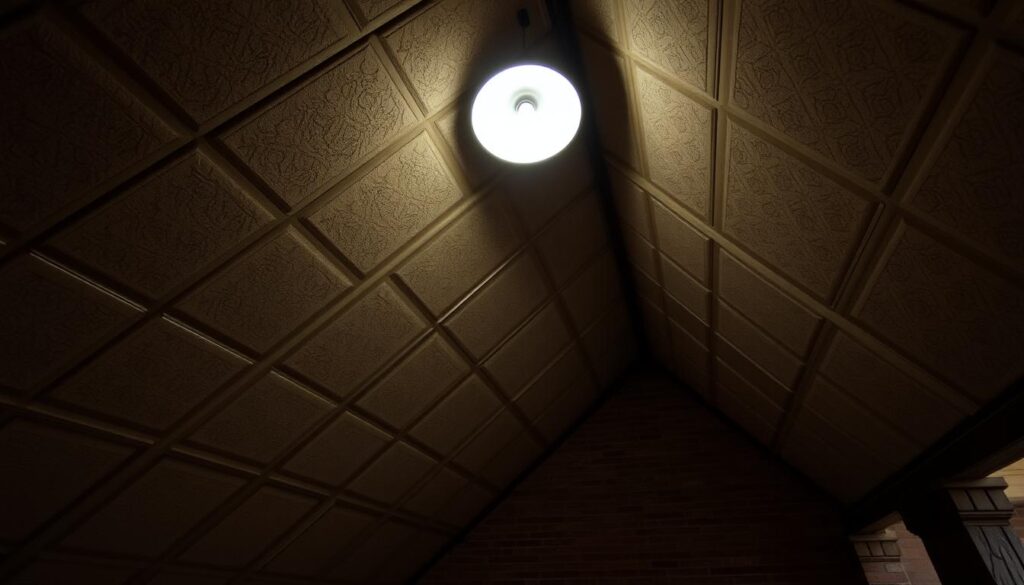
Thin Soundproofing Solutions for Party Walls
To tackle noise issues through party walls, consider implementing a thin soundproofing solution that is both effective and unobtrusive. These solutions are designed to minimise disturbance without requiring significant renovations or extensive construction.
Using Acousticel M20AD
The Acousticel M20AD insulation is a highly effective material for soundproofing party walls due to its ease of installation and thin profile. It can be easily cut and bonded to the wall using Sta-Stuk aerosol contact adhesive. When combined with two layers of 15mm acoustic plasterboard, it provides a robust soundproofing solution.
Acousticel M20AD is a versatile solution that can be used in various settings, offering a reliable method to enhance soundproofing without compromising on space.
Acoustic Plasterboard Installation
Acoustic plasterboard is a denser alternative to standard plasterboard, offering enhanced sound-blocking properties. To install, measure and cut the acoustic plasterboard to size, then fix it to the wall, ensuring staggered joints between the two layers to maximise soundproofing performance.
The installation process requires careful handling due to the heavier weight of acoustic plasterboard compared to standard plasterboard. It is essential to use appropriate fixings and consider additional support where necessary.
By combining Acousticel M20AD with acoustic plasterboard, you achieve a thin yet effective soundproofing solution that adds approximately 50mm to the wall thickness, making it suitable for most rooms.
How to Soundproof Party Wall DIY: Thick Solution Method
For persistent or severe noise problems, a more substantial soundproofing approach is often necessary. The thick solution method involves constructing a robust soundproofing system that can effectively minimise noise transmission through party walls.
Installing Timber Studs and Acoustic Mineral Wool
The first step in the thick solution method is to install timber studs within the party wall cavity. This creates a framework for the soundproofing materials. Acoustic mineral wool, such as that available in the UK, is then placed between the studs to absorb sound energy and reduce reverberation.
The correct installation of acoustic mineral wool is crucial for its effectiveness. Ensure it is cut to fit snugly between the studs, filling the entire cavity without compression.
Resilient Bars and Plasterboard Application
To further enhance the soundproofing performance, resilient bars are screwed horizontally across the timber studs. Two layers of acoustic plasterboard are then applied, with the first layer screwed to the resilient bars. To maximise sound reduction, a high-mass sound barrier mat, such as SBM5 Sound Barrier Mat, is sandwiched between the two plasterboard layers.
The use of resilient bars is critical as they decouple the plasterboard from the stud frame, creating a floating wall surface that minimises vibration transfer. Proper spacing and fixing methods are essential for optimal performance.
Dealing with Special Challenges
You may face specific obstacles when attempting to soundproof a party wall, particularly if it contains a chimney breast or electrical outlets. Effective soundproofing requires addressing these challenges directly to achieve optimal results.
Soundproofing Walls with Chimney Breasts
Soundproofing a wall that contains a chimney breast is never as effective as it would be without one. To improve soundproofing in such cases, start by inserting a thin black bin bag filled with fibreglass loft insulation into the fireplace, then brick up the fireplace flush with the outside of the chimney breast. This simple step can significantly enhance the overall soundproofing performance of the wall.
Addressing Electrical Outlets and Fixtures
Electrical outlets, light switches, and other wall fixtures can create weak points in your soundproofing system, allowing noise to pass through. To mitigate this, consider extending electrical boxes to accommodate additional wall thickness, sealing around fixtures with acoustic sealant, or repositioning outlets to avoid penetrating the soundproofing layer. Back-to-back electrical outlets on party walls are particularly problematic and may require special treatment, such as using acoustic putty pads. Ensuring these details are properly addressed is crucial for achieving optimal soundproofing performance in your space.
Advanced Soundproofing Techniques
For those looking to take their soundproofing efforts to the next level, advanced techniques can provide the solution needed to tackle even the toughest noise challenges. Advanced soundproofing involves employing a combination of materials and methods tailored to specific noise issues.
Combining Multiple Layers for Maximum Effect
To maximise soundproofing effectiveness, combining multiple layers of different materials is often the most effective strategy. This approach allows you to leverage the unique benefits of various soundproofing elements, such as high mass materials and acoustic mineral wool, to create a robust barrier against noise.
Sound Barrier Mat Applications
Sound barrier mats, such as the SBM5, are specialised high-mass products designed to enhance soundproofing. These mats are particularly effective when used between layers of plasterboard or as part of a multi-layer soundproofing system. Despite their thin profile, typically ranging from 2-5mm, they provide significant mass that helps block sound waves, particularly in the mid to high-frequency range.
When installing sound barrier mats, it’s crucial to follow proper cutting, handling, and fixing procedures. Using appropriate adhesives and ensuring correct decoupling between layers can significantly enhance the overall soundproofing performance of your wall construction.
Sound barrier mats are not only effective but also an environmentally friendly option, as many are made from recycled materials. Their ability to offer an excellent balance of performance and space efficiency makes them a valuable component in most DIY soundproofing projects.
Finishing Touches and Decoration
The final stage of soundproofing involves preparing your wall for decoration. With your soundproofing measures in place, you can now focus on the aesthetic aspects that will enhance the overall appearance of your newly soundproofed wall.
Sealing Gaps and Joints
Before decorating, it’s essential to seal any gaps or joints in your soundproofed wall. Use an acoustic sealant to fill any openings, ensuring a tight seal that maintains the integrity of your soundproofing efforts. This step is crucial in preventing sound leakage and maintaining the acoustic performance of your wall.
Decorating Your Newly Soundproofed Wall
When decorating, you have a range of options, including paint, wallpaper, and textured coatings. For acoustic plasterboard, apply a suitable primer and base coat before finishing with your chosen decorative treatment. Be mindful of the added thickness of your soundproofed wall when installing skirting boards and coving. Certain heavy wall coverings can enhance soundproofing by adding mass. Proper finishing protects the soundproofing system, ensuring its longevity and maintaining the quality of your space.
Cost vs. Performance Analysis
Balancing the cost of soundproofing materials and installation with the desired level of noise reduction is key. When soundproofing a party wall, you need to consider both the upfront costs and the long-term benefits.
Effective soundproofing can significantly enhance your living environment, but it’s essential to evaluate the cost-performance ratio to make informed decisions.
Budget-Friendly Options
For those on a tight budget, there are several cost-effective soundproofing solutions available. Using materials like acoustic mineral wool and resilient bars can significantly improve soundproofing without breaking the bank.
DIY approaches, such as adding mass to walls or sealing gaps, can also be effective and affordable.
When to Consider Professional Installation
While DIY solutions can be effective for minor noise issues, severe problems may require professional soundproofing services. If you’re dealing with significant noise disturbances or have complex structural issues, consider hiring a professional.
Professional installation offers access to high-quality materials, expert knowledge, and performance guarantees, ensuring optimal results.
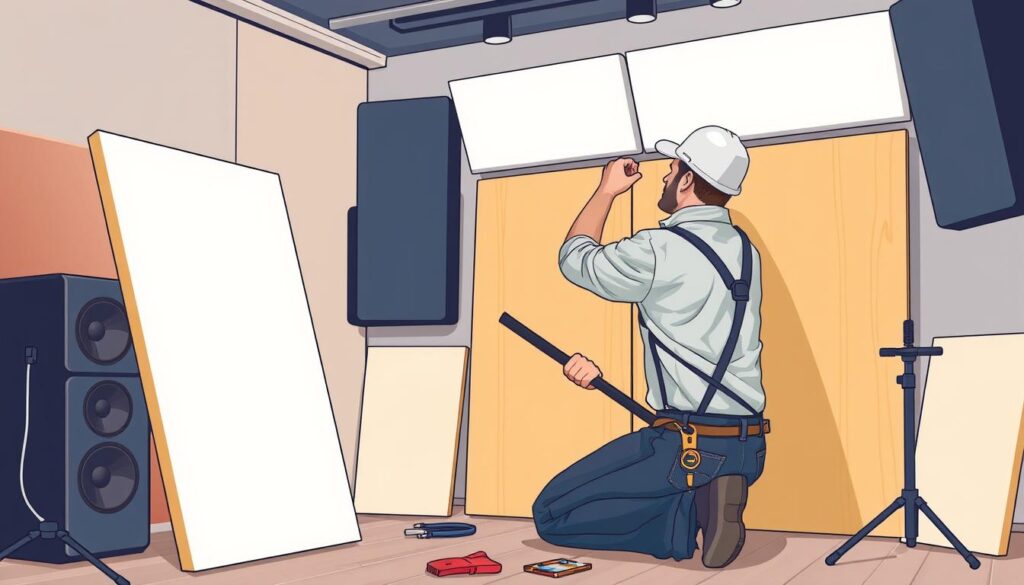
Conclusion
Enhancing your home’s tranquility through party wall soundproofing is a worthwhile investment. By implementing the DIY soundproofing techniques outlined in this article, you can significantly reduce noise disturbance from neighbours. The key approaches to soundproofing your party wall range from simple, thin solutions to more comprehensive, thick systems.
It’s essential to address flanking noise paths and pay attention to detail during installation for optimal results. Soundproofing is typically a balance between space, cost, and performance. Even partial soundproofing measures can improve your quality of life.
Carefully assess your specific noise problems before selecting a soundproofing approach to ensure the solution matches your needs. For persistent or severe noise issues, combining multiple techniques or seeking professional advice may be necessary. Effective party wall soundproofing can bring significant improvements in peace and comfort to UK homes.
